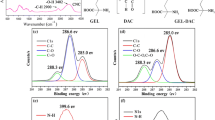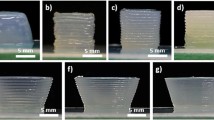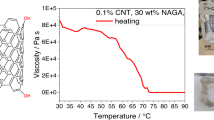Abstract
In this study, a novel hydrogel preparation method was developed to formulate a 3D printable hydrogel with low swelling ratio for biomedical scaffolds. Nanocellulose fibrils were first oxidized to synthesize dialdehyde cellulose nanocrystals (DACs). The aldehyde groups on DACs could crosslink with laponite nanoclay via an esterification reaction. The mechanism between the two materials through aldehyde and hydroxyl groups was further confirmed by FTIR results. To optimize the printability and printing quality of the prepared hydrogels, the rheological properties of the gels were carefully examined to understand the shear thinning effect and the thixotropic responses. An optimal hydrogel composition of 6 wt% laponite and 1 wt% DACs showed the best results to accurately print 3D structures with a nozzle dispenser. The printed gel structures exhibited high mechanical strength and low swelling effect without complicated post treatment steps. Several examples were also demonstrated to show the structural stability, accuracy, and cell viability of the printed hydrogel structures for potential in 3D bio-printing applications.







Similar content being viewed by others
Data availability
The results/data/figures in this manuscript have not been published elsewhere, nor are they under consideration by another publisher. All of the material is owned by the authors and/or no permissions are required.
References
Ahlfeld T, Cidonio G, Kilian D, Duin S, Akkineni A, Dawson J, Yang S, Lode A, Oreffo R, Gelinsky M (2017) Development of a clay based bioink for 3D cell printing for skeletal application. Biofabrication 9:034103. https://doi.org/10.1088/1758-5090/aa7e96
Bettinger CJ, Langer R, Borenstein JT (2009) Engineering substrate topography at the micro-and nanoscale to control cell function. Angew Chem Int Ed 48:5406–5415. https://doi.org/10.1002/anie.200805179
Chimene D, Lennox KK, Kaunas RR, Gaharwar AK (2016) Advanced bioinks for 3D printing: a materials science perspective. Ann Biomed Eng 44:2090–2102. https://doi.org/10.1007/s10439-016-1638-y
Dávila JL, d’Ávila MA (2019) Rheological evaluation of Laponite/alginate inks for 3D extrusion-based printing. Int J Adv Manuf Technol 101:675–686. https://doi.org/10.1007/s00170-018-2876-y
Donderwinkel I, Van Hest JC, Cameron NR (2017) Bio-inks for 3D bioprinting: recent advances and future prospects. Polym Chem 8:4451–4471. https://doi.org/10.1039/C7PY00826K
Du Z, Yu X, Han Y (2018) Inkjet printing of viscoelastic polymer inks. Chin Chem Lett 29:399–404. https://doi.org/10.1016/j.cclet.2017.09.031
Duty C et al (2018) What makes a material printable? A viscoelastic model for extrusion-based 3D printing of polymers. J Manuf Process 35:526–537. https://doi.org/10.1016/j.jmapro.2018.08.008
French AD (2017) Glucose, not cellobiose, is the repeating unit of cellulose and why that is important. Cellulose 24:4605–4609. https://doi.org/10.1007/s10570-017-1450-3
Gao T, Gillispie GJ, Copus JS, Pr AK, Seol Y-J, Atala A, Yoo JJ, Lee SJ (2018) Optimization of gelatin–alginate composite bioink printability using rheological parameters: a systematic approach. Biofabrication 10:034106. https://doi.org/10.1088/1758-5090/aacdc7
Golafshan N, Rezahasani R, Esfahani MT, Kharaziha M, Khorasani S (2017) Nanohybrid hydrogels of laponite: PVA-Alginate as a potential wound healing material. Carbohydr Polym 176:392–401. https://doi.org/10.1016/j.carbpol.2017.08.070
Gong J, Li J, Xu J, Xiang Z, Mo L (2017) Research on cellulose nanocrystals produced from cellulose sources with various polymorphs. RSC Adv 7:33486–33493. https://doi.org/10.1039/C7RA06222B
Gopinathan J, Noh I (2018) Recent trends in bioinks for 3D printing. Biomater Res 22:1–15. https://doi.org/10.1186/s40824-018-0122-1
Grosskopf AK, Truby RL, Kim H, Perazzo A, Lewis JA, Stone HA (2018) Viscoplastic matrix materials for embedded 3D printing. ACS Appl Mater Interfaces 10:23353–23361. https://doi.org/10.1021/acsami.7b19818
Guvendiren M, Molde J, Soares RM, Kohn JJAbs, engineering, (2016) Designing biomaterials for 3D printing. ACS Biomater Sci Eng 2:1679–1693. https://doi.org/10.1021/acsbiomaterials.6b00121
Hausmann MK et al (2018) Dynamics of cellulose nanocrystal alignment during 3D printing. ACS Nano 12:6926–6937. https://doi.org/10.1021/acsnano.8b02366
Holback H, Yeo Y, Park K (2011) Hydrogel swelling behavior and its biomedical applications. In: Biomedical hydrogels. Elsevier
Hospodiuk M et al (2017) The bioink: a comprehensive review on bioprintable materials. Biotechnol Adv 35:217–239. https://doi.org/10.1016/j.biotechadv.2016.12.006
Huang W, Wang Y, McMullen LM, McDermott MT, Deng H, Du Y, Chen L, Zhang L (2019) Stretchable, tough, self-recoverable, and cytocompatible chitosan/cellulose nanocrystals/polyacrylamide hybrid hydrogels. Carbohydr Polym 222:114977. https://doi.org/10.1016/j.carbpol.2019.114977
Jakab K, Norotte C, Marga F, Murphy K, Vunjak-Novakovic G, Forgacs G (2010) Tissue engineering by self-assembly and bio-printing of living cells. Biofabrication 2:022001. https://doi.org/10.1088/1758-5082/2/2/022001
Jang T-S, Jung H-D, Pan HM, Han WT, Chen S, Song J (2018) 3D printing of hydrogel composite systems: recent advances in technology for tissue engineering. Int J Bioprinting. https://doi.org/10.18063/ijb.v4i1.126
Jiang Y, Zhou J, Yang Z, Liu D, Xv X, Zhao G, Shi H, Zhang Q (2018) Dialdehyde cellulose nanocrystal/gelatin hydrogel optimized for 3D printing applications. J Mater Sci 53:11883–11900. https://doi.org/10.1007/s10853-018-2407-0
Jin Y, Chai W, Huang Y (2017a) Printability study of hydrogel solution extrusion in nanoclay yield-stress bath during printing-then-gelation biofabrication. Mater Sci Eng C 80:313–325. https://doi.org/10.1016/j.msec.2017.05.144
Jin Y, Liu C, Chai W, Compaan A, Huang Y (2017b) Self-supporting nanoclay as internal scaffold material for direct printing of soft hydrogel composite structures in air. ACS Appl Mater Interfaces 9:17456–17465. https://doi.org/10.1021/acsami.7b03613
Kuo C, Qin H, Acuña D, Cheng Y, Jiang X, Shi X (2019) Printability of hydrogel composites using extrusion-based 3D printing and post-processing with calcium chloride. J Food Sci Nutr 5:051. https://doi.org/10.24966/FSN-1076/100051
Larsson PA, Kochumalayil JJ, Wågberg L (2013) Oxygen and water vapour barrier films with low moisture sensitivity fabricated from self-cross-linking fibrillated cellulose. In 15th fundamental research symposium: advances in pulp and paper research, pp 851–866. The Pulp and Paper Fundamental Research Society Cambridge, UK
Li H et al (2018) Review of 3D printable hydrogels and constructs. Mater Des 159:20–38. https://doi.org/10.1016/j.matdes.2018.08.023
Mobaraki M, Ghaffari M, Yazdanpanah A, Luo Y, Mills D (2020) Bioinks and bioprinting: a focused review. Bioprinting 18:e00080. https://doi.org/10.1016/j.bprint.2020.e00080
Ozbolat IT, Yu Y (2013) Bioprinting toward organ fabrication: challenges and future trends. IEEE Trans Biomed Eng 60:691–699. https://doi.org/10.1109/TBME.2013.2243912
Rutz AL, Hyland KE, Jakus AE, Burghardt WR, Shah RN (2015) A multimaterial bioink method for 3D printing tunable, cell-compatible hydrogels. Adv Mater 27:1607–1614. https://doi.org/10.1002/adma.201405076
Rutz AL, Lewis PL, Shah RN (2017) Toward next-generation bioinks: tuning material properties pre-and post-printing to optimize cell viability. MRS Bull 42:563–570. https://doi.org/10.1557/mrs.2017.162
Sun B, Hou Q, Liu Z, Ni Y (2015) Sodium periodate oxidation of cellulose nanocrystal and its application as a paper wet strength additive. Cellulose 22:1135–1146. https://doi.org/10.1007/s10570-015-0575-5
Sun H, Kim Y, Kim YC, Park IK, Suhr J, Byun D, Choi H, Kuk K, Baek OH, Jung Y (2018) Self-standing and shape-memorable UV-curing epoxy polymers for three-dimensional (3D) continuous-filament printing. J Mater Chem C 6:2996–3003. https://doi.org/10.1039/C7TC04873D
Yao C, Wang F, Cai Z, Wang X (2016) Aldehyde-functionalized porous nanocellulose for effective removal of heavy metal ions from aqueous solutions. RSC Adv 6:92648–92654. https://doi.org/10.1039/C6RA20598D
Zhang B, Wang Q, Zhang Y, Gao W, Hou Y, Zhang G (2019) A self-assembled, nacre-mimetic, nano-laminar structure as a superior charge dissipation coating on insulators for HVDC gas-insulated systems. Nanoscale 11:18046–18051. https://doi.org/10.1039/C9NR06827A
Acknowledgements
This study is supported by the National Science and Technology Council in Taiwan (NSTC 112-2221-E-002-026 -MY3 and NSTC112-2622-E-002-035).
Funding
This work is supported by National Science and Technology Council (NSTC 112-2221-E-002026 -MY3 and NSTC112-2622-E-002-035).
Author information
Authors and Affiliations
Contributions
YCL, WTK, and DYC wrote the main manuscript text. WTK, IFW, and DYC prepared figures. All authors reviewed the manuscript.
Corresponding author
Ethics declarations
Conflict of interest
The authors declare no competing interests.
Ethical approval
Comply with ethical standards.
Consent for publication
The manuscript has been approved for publication by all authors.
Additional information
Publisher's Note
Springer Nature remains neutral with regard to jurisdictional claims in published maps and institutional affiliations.
Rights and permissions
Springer Nature or its licensor (e.g. a society or other partner) holds exclusive rights to this article under a publishing agreement with the author(s) or other rightsholder(s); author self-archiving of the accepted manuscript version of this article is solely governed by the terms of such publishing agreement and applicable law.
About this article
Cite this article
Ke, WT., Cheng, DY., Wu, IF. et al. 3D printed anti-swelling hydrogel scaffold with dialdehyde cellulose nanocrystals. Cellulose 31, 2975–2988 (2024). https://doi.org/10.1007/s10570-024-05789-w
Received:
Accepted:
Published:
Issue Date:
DOI: https://doi.org/10.1007/s10570-024-05789-w




